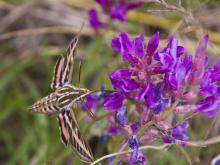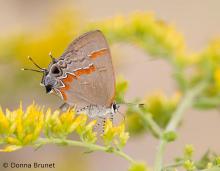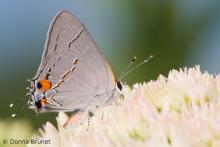Butterflies and Moths
Media

Species Types
Scientific Name
About 75 species in North America north of Mexico
Description
Missouri has 16 species of saturniid, or giant silkworm moths. Many of them are spectacular, including the cecropia, luna, buck, io, imperial, polyphemus, rosy maple, spiny oakworm, and royal moths.
Media

Species Types
Scientific Name
Hyalophora cecropia
Description
The cecropia moth looks a lot like butterfly ― but note its feathery antennae and stout, hairy body. This is the largest moth native to North America.
Media

Species Types
Scientific Name
Antheraea polyphemus
Description
The polyphemus is the second-largest Missouri moth. It was named after Homer's giant one-eyed monster in The Odyssey because of the big eyespot on each hindwing.
Media

Species Types
Scientific Name
More than 50 species in Missouri
Description
Sphinx moths are usually large and heavy bodied, with a long, pointed abdomen. Members of this family often hover near flowers, feeding on nectar and looking like hummingbirds or bumblebees.
Media

Species Types
Scientific Name
More than 12,000 species in North America north of Mexico
Description
Learn about moths as a group. What makes a moth a moth? How are moths different from butterflies? What are the major groups of moths?
Media

Species Types
Scientific Name
Nymphalis antiopa
Description
The unmistakable mourning cloak is a familiar woodland butterfly in Missouri. Adults hibernate and are sometimes seen flying on warm, sunny days in winter.
Media

Species Types
Scientific Name
Calycopis cecrops
Description
The red-banded hairstreak has a unique pattern of white, black, and red-orange bands on the underside hindwing. It is most common in the Ozarks.
Media

Species Types
Scientific Name
Strymon melinus
Description
The gray hairstreak, a small gray butterfly, is widespread throughout the United States. In Missouri, there are three or more broods each year.
Media

Species Types
Scientific Name
More than 700 species in North America north of Mexico
Description
Learn about butterflies and skippers as a group. What makes a butterfly a butterfly? How are they different from moths? What are the major groups of butterflies?
See Also


Media

Species Types
Scientific Name
About 1,500 species in North America north of Mexico
Description
Adult caddisflies are mothlike. Their larvae are aquatic and build portable, protective cases out of local materials, including grains of sand, bits of leaves and twigs, and other debris.
Media

Species Types
Scientific Name
Corydalus cornutus
Description
Adult eastern dobsonflies are huge and mothlike, with large wings and a weak, fluttery flight. The fiercely predaceous aquatic larvae, called hellgrammites, are well-known to anglers, who often use them as bait.
About Butterflies and Moths in Missouri
Butterflies, skippers, and moths belong to an insect order called the Lepidoptera — the "scale-winged" insects. These living jewels have tiny, overlapping scales that cover their wings like shingles. The scales, whether muted or colorful, seem dusty if they rub off on your fingers. Many butterflies and moths are associated with particular types of food plants, which their caterpillars must eat in order to survive.





















